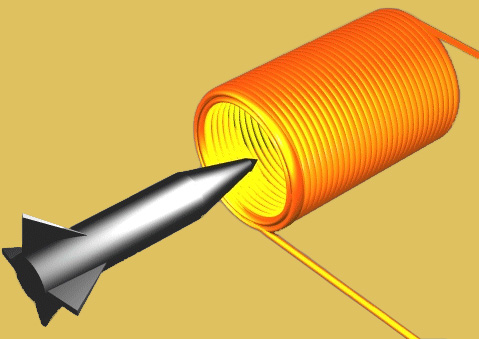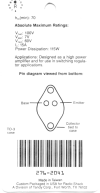
Magnetic Levitation
Levitation
- Introduction
- Why
- Other Maglev
- Hard Drive Maglev
- Schematic
- Parts List
- Buying Parts
- Woodworking
- Other's
- Photographs
- Infrared Emitter
- Photodetector
- Reference Det
- Difference Amp
- Feedback Loop
- Loop Equations
- Bode Plot
- Phase Lead
- Output Amp
- Coil Driver
- PWM
- Lifting Coil
- PSPICE
- Build Time
- PCB
- Power Supplies
- Setup
- Test Power
- Test IR Emitter
- Test Signal Det
- Test Ref Det
- Adjust Sensing Res
- Test Diff Amp
- Test Non-Invert Amp
- Test Coil Driver
- Test Lifting Coil
- Results
Testing the Output Transistor
The output transistor controls the high current flowing through the coil. To read about the levitator's coil driver design look here.
See If It's Working
Here are some tips to check out.
- Do you have the right transistor? To help identify it, this photo shows the package from Radio Shack. It also lists the maximum ratings. A lower-rated transistor would probably also work well.
 Are
the transistor's pins connected properly? The 2n3055 is an NPN silicon power transistor.
Here is a cheesy ASCII chart. Here some pin diagrams as viewed from the bottom.
Are
the transistor's pins connected properly? The 2n3055 is an NPN silicon power transistor.
Here is a cheesy ASCII chart. Here some pin diagrams as viewed from the bottom.
_ /O\ mounting hole = collector tied to case / \ base---/-o o-\---emitter / \ \ / \ / \ O / mounting hole (also the collector) \_/It's easiest to just solder the wires to the two terminals, and then put a solder lug terminal on the screw through one of the mounting holes.- Do you really need the heat sink? Probably not. I mounted the transistor on a heat sink because I didn't know when I started if it was necessary. But it never gets any noticeable temperature rise. There is not much heat dissipated in there anyway because it runs either full-on or shut off, switching back and forth at a couple of kHz at whatever pulse width is needed to suspend the object. This is a natural consequence of having a large gain; the final drive stage isn't running in a linear mode, it's really in switching mode.
Overheating
Is the transistor too hot? That is a sign that it's not fully turned on. If it's too hot to touch, you have a problem. It may soon melt its internal solder joints and quit working.
Either one of two things will help. Replacing it with an identical power transistor, or reducing the 300 ohm base resistor value.
The reason that swapping the transistor can help is that some transistors have higher gain than others, even from the same manufacturing batch. A higher gain transistor will conduct more current when given the same base (input) current. The gain is measured in 'beta' which is a simple ratio between output current (collector) and input current (base). Typical values can easily range from 50 to over 100 for these power transistors.
Here's why this transistor should run cool... The output transistor is meant to turn completely fully ON when the coil should be on. This is also known as operating in saturation. This means maximum current, but a fully-on transistor a very small voltage between emitter to collector. Since power and therefore heat production is the product of current and voltage, it will run cool because its voltage drop is so low. Sample numbers are: a fully-on transistor has 0.2v between emitter and collector, and suppose the coil takes 1.5 amps. The power dissipation is 0.2v * 1.5 = 300 mW. That will let the power transistor stay very cool.
So how can you verify this is really your problem? Setup the levitator so the coil should stay fully on. Measure the voltage between the emitter and collector. If it's greater 0.5v then the transistor is not being turned on completely, and it will overheat unless something is changed.
The other item was the 300 ohm base resistor. Replace it with a 200 ohm or so resistor, or put another 300 ohm base resistor in parallel with it, to effectively get a 150 ohm resistor. The actual value is not critical, as long as you get that sucker fully turned on.
| < Previous | Page 35 of 37 | Next > |
©1998-2025 Barry Hansen